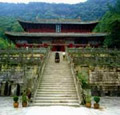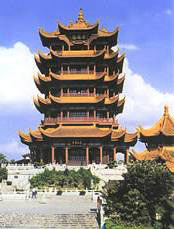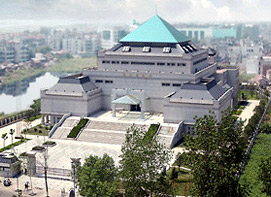|
Landscape
(2004-09-02 18:28:18)
Blessed with beautiful mountains and rivers and a rich, vibrant culture, Hubei has an abundance of fascinating tourist attractions.
The world-famous Three Gorges, renowned for their spectacular views, rank in the top ten scenic spots in China.
But the gorges are not Hubei's only attraction. Shennongjia has been included in the Protection Plan for Man and Nature by the United Nations Educational, Scientific and Cultural Organization (UNESCO), and Wudang Mountain and Mingxian Tomb have been designated World Culture Heritage sites.
Hubei Museum, a provincial museum famous throughout the country, possesses a large number of world-class ancient relics, while Guqintai has the deeply moving friendship story of Yu Boya and Zhong Ziqi who became inseparable friends through their shared appreciation of the melody "High Mountain and Flowing Water."

Three Gorges
Recognized as one of the top ten scenic spots in China, the Three Gorges provide the most stunning sights and scenery along the Yangtze River, China's longest waterway.
The Three Gorges consist of Qutang Gorge, Wu Gorge, and Xiling Gorge, stretching 193 kilometres from Baidicheng in Fengjie, and Chongqing in the west, to Nanjinguan in Yichang, Hubei in the east. Within the territory of Hubei are 134 kilometres of the stretch and Xiling Gorge.
Qutang Gorge, the western arm of the Three Gorges, is best known for its power and magnificence. At its narrowest point, which is less than 100 metres across, the river rushes and roars like thousands of horses galloping through a gate, giving this spot the name of the First Gate in the World.
Wu Gorge, with its long stretch and deep valley, is charming and exquisite. Twelve Peaks line the banks of the gorge there, all endowed with great beauty. Among them the Goddess Peak is the most enchanting.
Xiling Gorge is the longest and most perilous stretch, characterized by its many shoals and turbulent water.
Close to both sides of the Three Gorges are many scenic spots and places of historic interest, including Baidicheng, the Daning River and Three Little Gorges, Shennong Brook, Qu Yuan Memorial Temple, Zhaojun's hometown, and Sanyou Cave. The Three Gorges Dam is located at the mouth of Xiling Gorge, 38 kilometres away from the Gezhou Dam downstream.

Shennongjia
Shennongjia is situated in western Hubei, covering an area of over 3,000 square kilometres. The special terrain there creates a warm and humid climate, making it a paradise for plants and animals at the meeting point of North and South China.
Known as the Oriental Natural Botanic Garden and a natural gene bank for biological species, it shelters some of the world's rarest and most endangered plants and animals, such as Chinese dove trees, South China Tigers, white bears and white snakes.
Shennongjia is considered a sacred green land where primitive natural ecology is well preserved. In 1986, with the approval of the State Council, Shennongjia became the National Nature Reserve of Forests and Wild Animal Species. In 1990, UNESCO accepted it into the Protection Plan for Man and Nature.
The tourist resources there provide an array of attractions, ranging from primitive forests, mountains and valleys, to waterfalls, rare plants and animals and the mysterious "wild men." Scientific research, study, adventure, sightseeing, skiing and snow sports are all reasons to visit there.
There are over 20 major scenic spots in Shennongjia, including Fengjingya, Hongping Valley, Shennong Top, Source of Fragrant Brook and Dajiu Lake.
Shennong Top, known as the first peak in Central China, is 3,105 metres above sea level, and traces of ancient floods are still evident on the mountain top, the slope, and the surface of huge exposed boulders.
Fengjingya is a dream-like place with many spectacular views, including spectacular cloud formations, exotic stone poles and stone peaks, and magnificent mountains reflected in the lucid water.

Wudang Mountain
Wudang Mountain, located in Shiyan in western Hubei, is both a famous scenic spot and the Taoist Holy Land in China. The ancient architectural complex on the mountain was listed by UNESCO in 1994 as a World Culture Heritage Site.
The natural scenery of Wudang Mountain is powerful and magnificent, tinged with some fantastically serene and charming touches.
Major scenic spots include 72 peaks, 36 rocky cliffs, and 24 streams. Tianzhu Peak, its highest point, creates a striking view of "One Pole Supporting the Sky." Clustered around it are numerous smaller ones, composing a fantastic picture of 72 peaks paying homage to the main one.
Wudang Mountain is renowned as Immortals's Mountain of Taoism and the World for Swordsman. It is a famous Taoist centre in China with a long history of Taoist practice and a profound Taoist culture. Wudang Mountain is also well-known for its deep-rooted tradition of wushu (martial arts). As an old saying goes: "Shaolin wushu is the best in the north, while Wudang wushu is the best in the south."
Wudang's ancient architectural complex consists of eight palaces, two Taoist temples, 72 rock temples, 12 pavilions and 10 shrines. Large in scale and excellent in technical detail, it is a powerful demonstration of the harmony between architecture and nature. Inspired by the fairyland picture of the perfect blending of buildings and mountains, Wudang architectural complex is known as the Imperial Palace on the Cliff.

Yellow Crane Tower
Located on the Snake Hill in Wuchang, Yellow Crane Tower is one of the four famous towers in China. According to records, the tower was first built in 223 AD as a Wu Kingdom military lookout. Over its 1,700-year history, Yellow Crane Tower was destroyed many times in different dynasties, only to be rebuilt again and again. Construction of the present tower was completed in 1985.
Among the famous towers south of the Yangtze River, Yellow Crane Tower has been the most inspirational for celebrities and poets. It faces the great Yangtze River northwards, with the other three sides facing the downtown areas. The architectural complex comprises the tower, the pavilions, the corridors and the honorific arches.
The five-storey tower is 51.4 metres high. Strolling through the corridors of the tower and the pavilions, you can have a great view of the city, the bridge and the river.
In the shadow of Yellow Crane Tower is White Cloud Pavilion on top of Snake Hill, which is four-storied and 29.7 metres high. This is how Wuhan got the nickname of White Cloud and Yellow Crane.

Hubei Museum
Located on the East Lake, Hubei Museum is one of the best-known museums in China, showcasing numerous State-level historic and cultural relics. The Chime Bells Hall displays mainly the relics unearthed from Zenghouyi Tomb.
In 1978, 15,000 articles were excavated from the Zenghouyi Tomb in Suizhou, including bronze ritual vessels and weapons, horses and carts, articles made of bamboo, lacquer, gold, jade, bamboo tubes, coffins, and musical instruments.
Exhibited in this hall are very rare items such as the chime bells, the crane standing on the antler, gold cups and jade plates.
The Zenghouyi Chime Bells are the most historically important relics. The complete set includes 65 bells hanging on a three-tiered rack weighing over 2,000 kilograms. On the bells are gold-plated inscriptions about music. Each bell can emit two tones. After over 1,000 years, the bells still sound perfect, ready to play melodies local and foreign, classic and modern.
The Sword of Gou Jian, a king of Yue Kingdom, and the spear of Fu Chai, a king of Wu Kingdom, are both over 2,000 years old but still shiny and sharp. The lacquer wares used by ancient Chu people have exotic shapes and are truly marvelous.

The East Lake
The East Lake Scenic Area is located in Wuchang District of Wuhan. Characterized by its beautiful water and mountains, abundant plants, strong customs of Chu and unique gardens, it is a national key scenic area.
The East Lake Scenic Area, which consists of the East Lake and terrestrial scenic spots along the lake, has a total area of more than 80 square kilometres. The East Lake is the largest city lake in China, covering an area of 33 square kilometres.
Major places of interest are Tingtao (Listening to Surging Waves) Area, Moshao Hill Area, and Luo-Hong (Luojia Hill and Hong Hill) Area. Tingtao Area includes Kezhu House, Open Theatre, Tingtao House, Xingyin Pavilion, Pear Garden, Jiunu (nine women) Mound, Lake-centre Pavilion, and the Statue Fable Garden.
Moshan Hill Area stands southeastwards to the lake. Surrounded by the water on three sides, the mountain is 118 metres above sea level. In this area are Zhubei Pavilion and Qianfan Pavilion.
Moshan Botanic Garden and Chu Town, among which Moshan Botanic Garden has the most various types of plum blossoms and lotus in the world are also there. Luo-Hong Area is noted for its Cherry Blossom Festival on the campuses of Wuhan University, which is held very March or April and attracts a large number of sightseers.
|

